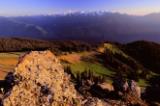 © Pete Saloutos/Panoramic Images (Washington Title Image Large)
© Pete Saloutos/Panoramic Images (Washington Title Image Large)

Ecoregions in Washington
What are ecoregions?
Ecoregions reflect broad ecological patterns occurring on the landscape. In general, each ecoregion has a distinctive composition and pattern of plant and animal species distribution. Abiotic factors, such as climate, landform, soil, and hydrology are important in the development of ecosystems, and thus help define ecoregions. Within an individual ecoregion, the ecological relationships between species and their physical environment are essentially similar.
Why use ecoregions?
Using ecoregions as a framework for assessing the distribution and status of species and ecosystems makes biological sense, compared to using politically derived lines like county, state or national boundaries. Ecoregions also provide an ecological basis for partitioning the state into subunits for conservation planning purposes.
What ecoregions occur in Washington?
Washington state contains portions of nine ecoregions, each of which is described on the following pages. These descriptions are intended to provide the reader with a snapshot of each ecoregion, and the statements regarding biodiversity highlights and conservation needs are not meant to be comprehensive.
Ecoregions in Washington
-
Northwest Coast Ecoregion
The Pacific Northwest Coast ecoregion includes most of the Olympic Peninsula of Washington.
-
Puget Trough Ecoregion
The Puget Trough ecoregion includes Puget Sound and surrounding foothills.
-
North Cascades ecoregion
The ecoregion includes the Cascade Mountains north of Snoqualmie Pass and west of the Cascade crest northward into British Columbia. It contains some of the largest expanses of wilderness in the lower forty-eight.
-
West Cascades ecoregion
In Washington, the West Cascades run southward from Snoqualmie Pass to the Columbia Gorge.
-
East Cascades ecoregion
The East Cascades ecoregion includes the mountains that lie east of the Cascade crest and the foothills as they flatten into the Columbia Plateau. In Washington, it stretches from roughly Lake Chelan in the north to the Columbia River Gorge in the south.
-
Okanogan ecoregion
The Okanogan ecoregion could be called the mountains between mountains - the broad highland area separating the North Cascades and the Northern Rockies in northeastern Washington.
-
Canadian Rocky Mountains ecoregion
The western edge of the Rocky Mountains form this ecoregion in Washington's northeastern corner. This area is also known as the Selkirk Mountains.
-
Blue Mountains Ecoregion
The Blue Mountains spill over into Washington's extreme southeastern corner. They are the westernmost ranges of the Middle Rockies that extend south into Oregon and east across central Idaho and into Montana.
-
Columbia Plateau ecoregion
The semi-arid Columbia Plateau occupies nearly one-third of the state. It is bordered by the Cascades to the west, the Okanogan Highlands to the north, the Rockies to the east, and the Blue Mountains to the southeast.















